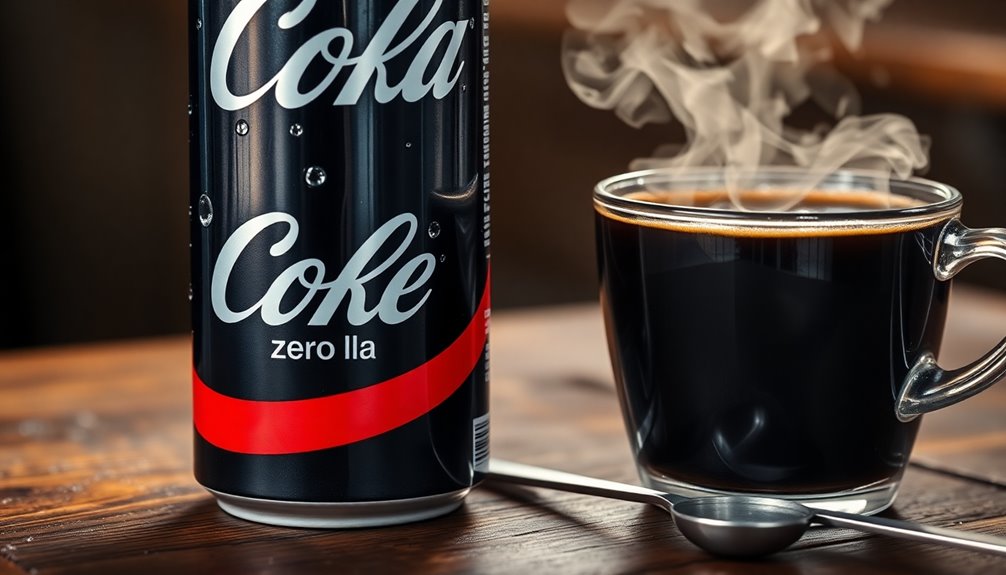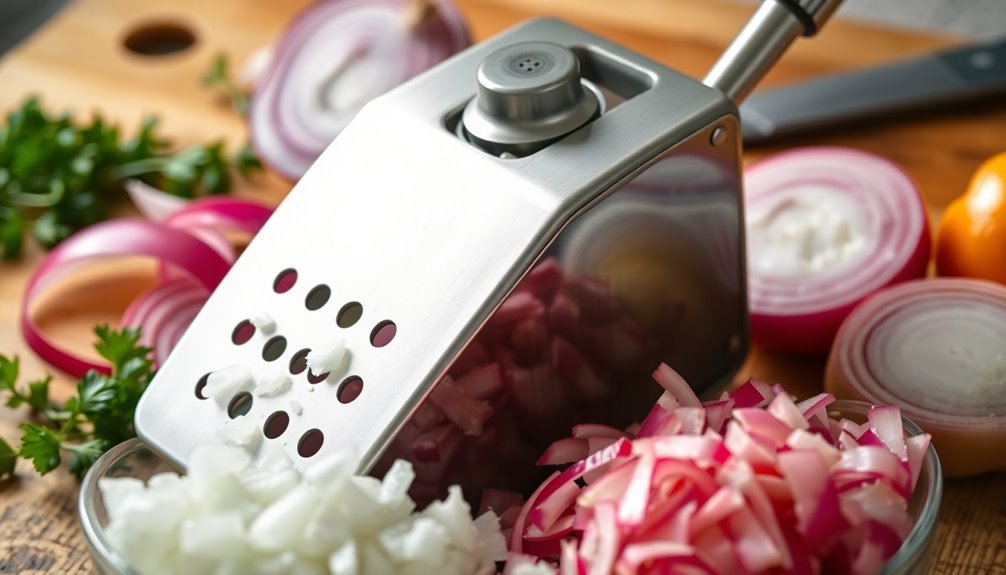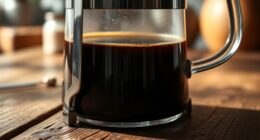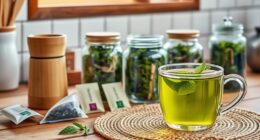Yes, a cappuccino has caffeine, and the amount varies based on size and espresso shots. For a small 6 oz cappuccino, you'll get about 40 to 64 mg of caffeine from one shot of espresso. If you opt for the standard 8 oz size, it contains around 80 to 128 mg, typically with two shots. Larger cappuccinos with three shots can have as much as 120 to 192 mg of caffeine. Factors like the coffee bean type and brewing method also play a role in caffeine levels. Stick around to discover more insights about this classic coffee drink.
Key Takeaways
- Yes, a cappuccino does contain caffeine, primarily derived from the espresso shots used in its preparation.
- A standard 6 oz cappuccino has about 40 to 64 mg of caffeine from one espresso shot.
- An 8 oz cappuccino typically contains approximately 80 to 128 mg of caffeine from two shots.
- Larger cappuccinos with three shots can yield caffeine levels ranging from 120 to 192 mg.
- The exact caffeine content can vary based on the espresso quality and brewing techniques used.
Understanding Cappuccino Basics

When you think of a cappuccino, picture a harmonious blend of espresso, steamed milk, and milk foam. This classic coffee drink typically consists of equal parts of each component, creating a creamy texture and rich flavor.
In a standard cappuccino, you'll find one to three shots of espresso, depending on the size. A small cappuccino usually has one shot, while an 8 oz or 12 oz drink often includes two shots. Larger options can pack in three shots.
The caffeine content mainly comes from the espresso, so if you're looking for a caffeine kick, the number of shots matters. Enjoying this delightful mix of flavors will surely elevate your coffee experience!
Caffeine Content Breakdown

Cappuccinos pack a punch when it comes to caffeine, making them a favorite for coffee lovers seeking an energy boost.
The caffeine content in a standard 8 oz cappuccino, typically made with two shots of espresso, ranges from 80 to 128 mg. If you opt for a smaller cappuccino with just one shot, you'll get about 40 to 64 mg of caffeine.
For those who enjoy larger sizes, a cappuccino with three shots can yield between 120 and 192 mg.
When compared to other coffee beverages like lattes, cappuccinos have similar caffeine levels, averaging around 173 mg per 16 oz serving.
Factors Influencing Caffeine Levels

Although many people enjoy cappuccinos for their rich flavor and creamy texture, several factors influence the caffeine levels in your cup. Understanding these components can help you gauge the caffeine content better:
- Quality of Espresso: A high-quality espresso shot can enhance caffeine extraction, providing a richer flavor and more caffeine.
- Type of Coffee Beans: Different beans have varying caffeine levels. For example, Robusta beans generally contain more caffeine than Arabica beans.
- Brewing Techniques: The grind size, water temperature, and extraction time can all affect caffeine extraction, impacting your cappuccino's overall caffeine levels. Additionally, the processing methods used on coffee beans can also influence the final caffeine concentration in your drink.
Comparing Cappuccino and Latte

While both cappuccinos and lattes deliver a satisfying caffeine kick, they differ markedly in texture and flavor. Both contain about 173 mg of caffeine from espresso, but their preparation sets them apart. A cappuccino features equal parts espresso, steamed milk, and milk foam, giving it a creamier texture. In contrast, lattes have more steamed milk, resulting in a smoother coffee drink. Additionally, the caffeine content in espresso remains a crucial factor in understanding how these beverages affect your daily intake.
| Feature | Cappuccino | Latte |
|---|---|---|
| Milk Ratio | Equal parts espresso, milk, foam | More steamed milk than espresso |
| Texture | Creamy due to foam | Smooth due to milk volume |
| Personal Preference | Stronger coffee flavor | Milder, creamier experience |
Ultimately, your choice between a cappuccino and a latte often comes down to personal preference.
Nutritional Information Overview

When you sip on a cappuccino, you're not just enjoying the rich flavor; you're also getting a unique nutritional profile.
Understanding the caffeine content and caloric values can help you make informed choices about your beverage.
Plus, knowing the nutritional benefits can enhance your coffee experience even more.
Caffeine Content Comparison
Cappuccinos pack a notable caffeine punch, making them a popular choice for coffee lovers seeking a boost.
The caffeine content in your cappuccino can vary based on several factors, including the espresso shots used and brewing techniques.
Here's a quick comparison:
- A small 6 oz cappuccino typically contains about 40-64 mg of caffeine from one espresso shot.
- A standard 16 oz cappuccino, with two shots, can provide around 80-128 mg of caffeine.
- In comparison, an 8 oz latte also has similar amounts, boasting roughly 80-128 mg of caffeine, thanks to its espresso base.
Caloric Values Explained
Understanding the caloric values of your favorite beverages is essential, especially when considering how they fit into your overall diet.
A standard cappuccino contains about 130 calories, primarily influenced by the type of milk used and any added sugars. The traditional cappuccino recipe, with equal parts espresso, steamed milk, and milk foam, offers a moderate caloric content. The ideal cappuccino temperature is around 150°F, allowing for the distinct layers of espresso, steamed milk, and milk foam to blend harmoniously. To enhance the flavor and texture of the drink, experienced baristas carefully monitor the temperature during the steaming and frothing process. Achieving the perfect cappuccino temperature is essential for delivering a satisfying and enjoyable coffee-drinking experience.
In contrast, an 8-ounce latte has around 206 calories due to its higher milk content. Your choice of milk—whole, skim, or plant-based—directly impacts the nutritional profile.
Additionally, customizations like flavored syrups can greatly increase caloric values, highlighting the importance of ingredient choices in your dietary considerations.
Moreover, coffee is known to enhance athletic performance, making it a popular choice for those looking to boost their workout efficiency.
Always be mindful of how these factors affect your cappuccino enjoyment!
Nutritional Benefits Overview
- Calorie Count: A standard cappuccino contains about 130 calories, mainly from the milk, with variations based on whole, skim, or plant-based milk choices.
- Protein Content: You get around 8 grams of protein per serving, which can help support muscle health and keep you feeling full.
- Fat and Carbohydrate Content: Cappuccinos have about 5 grams of fat and 13 grams of carbohydrates, making them a balanced option.
Be mindful that adding flavored syrups can alter the nutritional profile considerably by increasing both calorie and carbohydrate levels. Additionally, the caffeine in a cappuccino can provide a boost in cognitive function and energy levels.
Historical Background of Cappuccino

You might be surprised to learn that the name "cappuccino" comes from the Capuchin friars, whose brown robes mirror the drink's rich color.
Originating in Italy during the 16th century, this beloved beverage has evolved considerably over time, especially with the advent of espresso machines.
Origin of the Name
The name "cappuccino" has intriguing origins tied to the Capuchin friars, whose brown robes closely matched the drink's rich color. This espresso-based drink originated in Italy, reflecting a deep-rooted coffee culture.
Here's a brief history of its name:
- The term "cappuccino" derives from the Capuchin friars, emphasizing the drink's brown hue.
- The beverage traces its roots back to the 16th century when coffee was introduced to Europe.
- By the 1700s, it evolved from a simple mix of coffee, cream, and sugar to what we enjoy today.
With the rise of espresso machines post-World War II, cappuccinos became a staple in coffee shops, solidifying their place in modern coffee culture.
Evolution Over Time
Cappuccino's journey from its historical roots to its modern form is a fascinating evolution. Originating in the 17th century, the term "cappuccino" links to the Capuchin friars, whose brown robes mirrored the drink's hue.
It evolved from the "Kapuziner," a popular Viennese coffee preparation of coffee, cream, sugar, and spices. The early 20th century saw cappuccinos gain popularity in Italy with espresso machines enhancing quality and consistency.
Post-World War II, this delightful beverage spread across Western Europe and into American coffee shops by the 1980s, becoming a trendy choice.
You'll notice cultural variations too; Italians savor cappuccinos in the morning, while Americans enjoy them any time, reflecting differing coffee consumption habits and preferences.
Preparation Methods Explained

When crafting a cappuccino, it's essential to understand the balance of its ingredients to achieve that perfect blend of flavors and textures.
The classic cappuccino ratio of 1:1:1—equal parts espresso, steamed milk, and frothed milk—creates a creamy base that enhances the caffeine content.
Here's how to prepare it:
- Pull a shot of espresso: Focus on grind size and water temperature for ideal flavor extraction.
- Steam the milk: Aim for a velvety consistency that complements the espresso.
- Froth the milk: Use specific frothing techniques to achieve the thicker foam necessary for a cappuccino, differentiating it from other espresso-based drinks.
Master these preparation methods, and you'll enjoy a rich, flavorful cappuccino every time!
Flavor Profiles and Preferences

When you sip a cappuccino, you're not just enjoying a drink; you're experiencing a unique blend of bold coffee flavor and creamy texture.
This balance appeals to those who appreciate its rich taste and smaller portion compared to other coffee drinks.
Plus, cultural habits around cappuccino consumption can shape your preferences, making each cup a reflection of tradition and personal taste.
Taste and Texture Differences
While both cappuccinos and lattes have their unique appeal, the taste and texture differences can greatly influence your choice.
Here's what you can expect:
- Caffeine Content: Cappuccinos offer a stronger coffee flavor, thanks to equal parts espresso and steamed milk, making them more concentrated than lattes.
- Texture: The airy foam in cappuccinos creates a light mouthfeel, contrasting with the smoother, creamier texture of lattes that have more steamed milk.
- Flavor: Cappuccinos are often chosen for their robust coffee flavor, while lattes provide a milder taste, appealing to those who prefer a creamier experience.
Ultimately, your preference may depend on whether you enjoy the intense flavor of a cappuccino or the gentle richness of a latte.
Cultural Consumption Habits
Cappuccino consumption varies widely across cultures, reflecting distinct flavor profiles and preferences.
In Italy, the traditional flavor profile leans towards a strong coffee taste balanced with creamy milk froth, enjoyed primarily in the morning.
American coffee enthusiasts, however, have adapted cappuccinos into larger, more customizable drinks, often adding flavored syrups that alter the original taste. This shift caters to a diverse range of cultural preferences.
The creamy texture, achieved through equal parts steamed milk and foam, makes cappuccinos a favorite among those who seek a velvety mouthfeel in their espresso-based beverages.
Customization options, including the choice of whole, skim, or plant-based milk, allow you to tailor your cappuccino to your personal taste, enhancing your overall coffee experience. Additionally, many coffee shops today prioritize sustainable coffee sourcing, reflecting a growing demand for ethical consumption.
Health Considerations and Benefits

Enjoying a cappuccino can offer more than just a delightful taste; it also brings several health implications and benefits. Here are three key points to reflect on:
- Caffeine Content: With 80-128 mg of caffeine per serving, cappuccinos can enhance energy levels and metabolic rate, making them a great pick-me-up.
- Health Benefits: Moderate coffee consumption, including cappuccinos, is linked to improved brain function and a potential reduced risk of diseases, thanks to their antioxidant properties.
- Individual Tolerance: It's important to monitor your caffeine intake, as excessive consumption can lead to health issues like anxiety and insomnia.
Additionally, incorporating natural remedies alongside your cappuccino can further enhance overall well-being.
The general recommendation is to stay below 400 mg of caffeine per day for adults, accounting for your individual tolerance.
Common Myths About Cappuccino

Many people hold misconceptions about cappuccinos that can cloud their understanding of this popular drink. A common myth is that cappuccinos contain more caffeine than other espresso-based drinks. In reality, the caffeine content is similar because they typically use one or two espresso shots. The size of your cappuccino doesn't determine its caffeine level; that depends on the number of shots. The rich flavor you enjoy can come from the milk-to-coffee ratio, not more caffeine. Additionally, darker roasts aren't necessarily higher in caffeine due to longer roasting times. Variations in bean type and brewing techniques can also affect actual caffeine amounts. Regular filter replacement is important for maintaining optimal performance in your coffee preparation, just as it is with air purifiers.
| Common Myth | Truth | Impact on Caffeine Content |
|---|---|---|
| Larger size means more caffeine | Size doesn't affect caffeine levels | Depends on espresso shots |
| Dark roast has more caffeine | Longer roasting reduces caffeine | Affects all café drinks |
| Cappuccinos have same caffeine | Variations exist due to method | Influences your drink experience |
Frequently Asked Questions
Do Cappuccinos Have More Caffeine Than Coffee?
When comparing cappuccinos and coffee, you'll find that caffeine content can vary.
A cappuccino typically has 80-128 mg of caffeine, depending on the number of espresso shots. In contrast, an 8 oz brewed coffee usually contains around 95-200 mg.
So, while cappuccinos can be close in caffeine content, they often offer a different experience due to the steamed milk.
Ultimately, your choice depends on your taste preference and desired caffeine boost.
Is Cappuccino Strong in Caffeine?
Picture yourself wrapped in a cozy café, the aroma of freshly brewed espresso wafting through the air.
When you sip a cappuccino, you'll find it has a moderate caffeine kick. It's not as intense as a straight shot of espresso, but it packs a punch, too.
The combination of espresso and creamy milk creates a smooth experience, making it feel less potent than it actually is, depending on your personal caffeine tolerance.
Is a Cappuccino Unhealthy?
When you're considering if a cappuccino's unhealthy, it really depends on how you enjoy it.
Cappuccinos can be part of a balanced diet, offering antioxidants and moderate calories. However, if you're adding sugar or high-fat milk, it can tip the scales.
Keep an eye on your overall caffeine intake too; sticking to the recommended limit is key.
In moderation, a cappuccino can be a delightful treat rather than a health risk.
What's the Difference Between a Latte and a Cappuccino?
Think of a latte and a cappuccino as two siblings with distinct personalities.
You'll find a latte to be smooth and mellow, boasting more steamed milk and a velvety texture. In contrast, a cappuccino is a lively character, combining equal parts espresso, steamed milk, and frothy foam, creating a creamier mouthfeel.
If you crave bold coffee flavor, reach for a cappuccino; if you prefer a milder sip, a latte's your go-to.
Conclusion
So, you thought cappuccinos were just frothy delights devoid of caffeine? Surprise! These creamy concoctions pack a punch with about 75 mg of caffeine per serving. Ironically, while many sip them for the rich flavor and comforting warmth, they often overlook the energizing jolt they deliver. Now that you know, you might just find yourself craving that caffeine kick wrapped in velvety foam. Enjoy your next cup—it's not just a pretty face!










